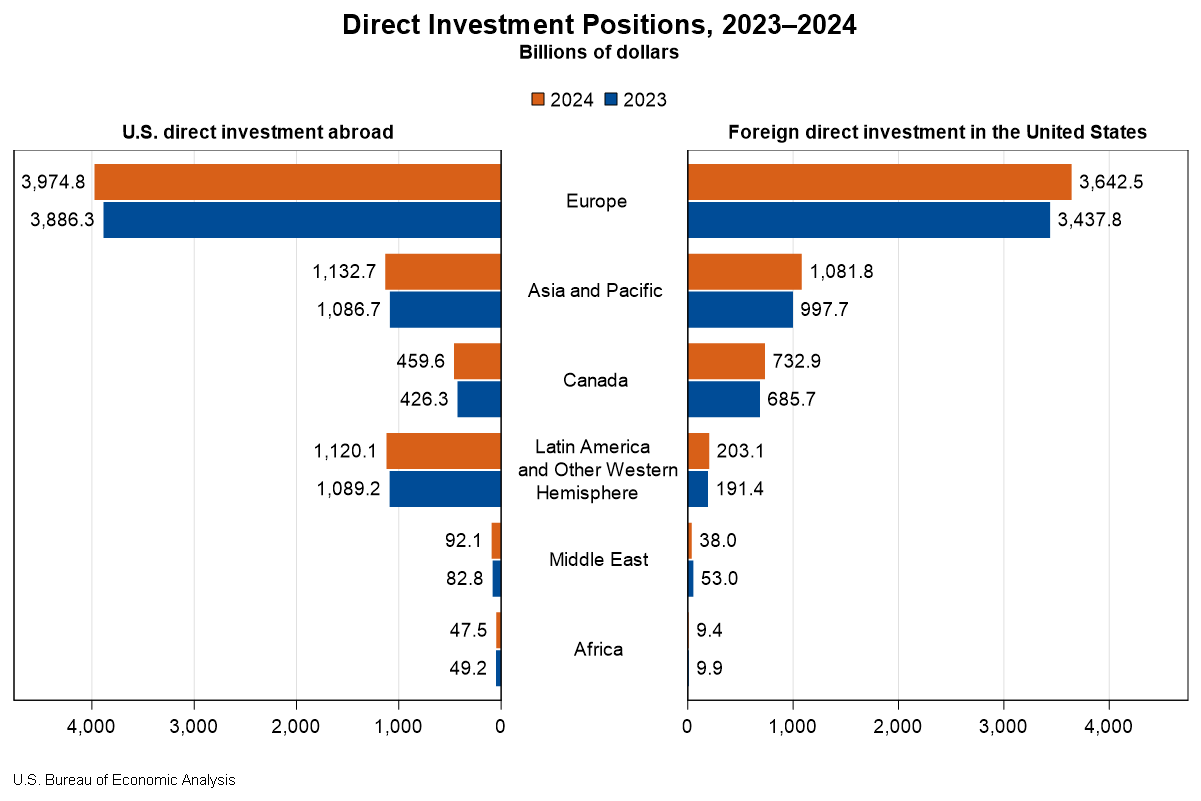Bureau of Economic Analysis
Direct Investment by Country and Industry, 2024
The U.S. direct investment abroad position, or cumulative level of investment, increased $206.3 billion to $6.83 trillion at the end of 2024, according to statistics released today by the U.S. Bureau of Economic Analysis. The increase was led by an $88.4 billion increase in the position in Europe, primarily in Luxembourg and Germany. By industry, manufacturing affiliates had the largest increase, led by manufacturing of computers and electronic products.
The foreign direct investment in the United States position increased $332.1 billion to $5.71 trillion at the end of 2024. The increase was led by a $204.7 billion increase in the position from Europe, which reflected a $52.9 billion increase from the United Kingdom and a $39.7 billion increase from Germany. By industry, affiliates in manufacturing increased the most.
Principal Federal Economic Indicators
Noteworthy
- 2025 News Release Schedule
- Innovation at BEA
- 2025 Annual Updates
- New! Services Trade Data for More Countries
- Data Tool: Trade in Value Added
- Distribution of State Personal Income
- Updated: RIMS II Regional Multipliers
- Arts and Culture
- Space Economy
- FDI Now in State BEARFACTS
- Quick Guide: Price Indexes
The Latest
Gross Domestic Product, Fourth Quarter and Year 2021 (Advance Estimate)
Real gross domestic product (GDP) increased at an annual rate of 6.9 percent in the fourth quarter of 2021, following an increase of 2.3 percent in the third quarter. The acceleration in the fourth quarter was led by an upturn in exports as well as accelerations in inventory investment and consumer spending. In the fourth quarter, COVID-19 cases resulted in continued restrictions and disruptions in the operations of establishments in some parts…
November 2021 Trade Gap is $80.2 Billion
The U.S. monthly international trade deficit increased in November 2021 according to the U.S. Bureau of Economic Analysis and the U.S. Census Bureau. The deficit increased from $67.2 billion in October (revised) to $80.2 billion in November, as imports increased more than exports. The previously published October deficit was $67.1 billion. The goods deficit increased $15.1 billion in November to $99.0 billion. The services surplus increased $…
U.S. International Trade in Goods and Services, November 2021
The U.S. monthly international trade deficit increased in November 2021 according to the U.S. Bureau of Economic Analysis and the U.S. Census Bureau. The deficit increased from $67.2 billion in October (revised) to $80.2 billion in November, as imports increased more than exports. The previously published October deficit was $67.1 billion. The goods deficit increased $15.1 billion in November to $99.0 billion. The services surplus increased $2.1…
U.S. International Investment Position, Third Quarter 2021
The U.S. net international investment position, the difference between U.S. residents’ foreign financial assets and liabilities, was –$16.07 trillion at the end of the third quarter of 2021, according to statistics released by the U.S. Bureau of Economic Analysis (BEA). Assets totaled $34.45 trillion, and liabilities were $50.53 trillion. At the end of the second quarter, the net investment position was –$15.91 trillion.
U.S. International Investment Position, Third Quarter 2021
The U.S. net international investment position (IIP), the difference between U.S. residents' foreign financial assets and liabilities, was –$16.07 trillion at the end of the third quarter of 2021, according to statistics released today by the U.S. Bureau of Economic Analysis (BEA). Assets totaled $34.45 trillion, and liabilities were $50.53 trillion. At the end of the second quarter, the net investment position was –$15.91 trillion.
Gross Domestic Product by State, 3rd Quarter 2021
Real gross domestic product increased in 37 states and the District of Columbia in the third quarter of 2021, as real GDP for the nation increased at an annual rate of 2.3 percent. The percent change in real GDP in the third quarter ranged from 6.0 percent in Hawaii to –3.3 percent in New Hampshire and North Dakota. GDP estimates reflect the continued economic impacts related to the COVID-19 pandemic. Government pandemic assistance payments…
Gross Domestic Product by State, 3rd Quarter 2021
Real gross domestic product (GDP) increased in 36 states and the District of Columbia in the third quarter of 2021, as real GDP for the nation increased at an annual rate of 2.3 percent, according to statistics released today by the U.S. Bureau of Economic Analysis (BEA). The percent change in real GDP in the third quarter ranged from 6.0 percent in Hawaii to –3.7 percent in New Hampshire.
Personal Income and Outlays, November 2021
Personal income increased$90.4 billion, or 0.4 percent at a monthly rate, while consumer spending increased$104.7 billion, or 0.6 percent, in November. The increase in personal income primarily reflected increases in compensation of employees and government social benefits. The personal saving rate (that is, personal saving as a percentage of disposable personal income) was 6.9 percent in November, compared with 7.1 percent in October.
Personal Income and Outlays, November 2021
Personal income increased$90.4 billion, or 0.4 percent at a monthly rate, while consumer spending increased$104.7 billion, or 0.6 percent, in November. The increase in personal income primarily reflected increases in compensation of employees and government social benefits. The personal saving rate (that is, personal saving as a percentage of disposable personal income) was 6.9 percent in November, compared with 7.1 percent in October.
Gross Domestic Product (Third Estimate), Corporate Profits (Revised Estimate), and GDP by Industry, Third Quarter 2021
Real gross domestic product (GDP) increased at an annual rate of 2.3 percent in the third quarter of 2021, following an increase of 6.7 percent in the second quarter. The increase was revised up 0.2 percentage point from the “second” estimate released in November. The deceleration in real GDP in the third quarter was led by a slowdown in consumer spending. A resurgence of COVID-19 cases resulted in new restrictions and delays in the reopening…




